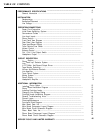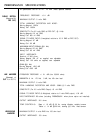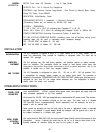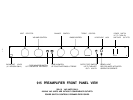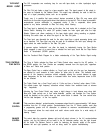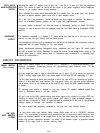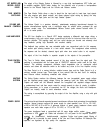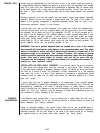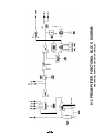
JFET
BUFFER AND
The output of the Selector System is followed by a very high input-impedance JFET buffer pair
RECORD OUTPUT
to establish negligible CMOS switch loading (for low distortion) and to provide a low-impedance
DRIVER
source for the Record Output and the Volume and Balance controls.
TAPE MONITOR
SWITCHING
VOLUME AND
BALANCE CONTROLS
LINE AMPLIFIER
TONE CONTROL
SYSTEM
MUTING
SYSTEM
POWER SUPPLY
The Tape Monitor Switch drives a relay to break the line input path to insert tape input signals.
The relay employs gold plated contacts, and allows optimum signal routing by placing the relay
close to the Tape Input jacks and the Input Selector System.
The Volume Control is a precision detented potentiometer employing laser-trimmed elements for
precise channel-balance tracking and a multi-finger wiper for smooth action, prolonged life, and
minimum contact noise. The center-detented Balance Control yields channel balance within 0.1
dB in its center position.
The 915 Line Amplifier is a Class-A JFET design employing a differential input stage, driving a
complementary high gain output stage, symmetrically driven for balanced slew-rate and low
harmonic distortion. This topology uses only four active devices per channel and extremely short
loop feedback, yielding high bandwidth and excellent stability.
The feedback loop contains two user selectable paths: one conventional path for flat response,
and another path allowing insertion of a tone control network. This arrangement allows maximally
flat response and the shortest, cleanest signal path when tone control action is not required.
The output of the Line Amplifier is capacitor coupled to the outputs of the preamplifier.
The Tone In Switch allows complete removal of the tone controls from the signal path. This
switching is accomplished with the same type of CMOS-FET electronic switch used for the Input
Selector. This switching arrangement eliminates signal degradation due to mechanical switch
contacts, and allows the electronic switch to be located very close to the Line Amplifier circuitry.
The Bass Control is of a moving inflection, variable turnover type, and the Treble Control is of a
shelving, variable turnover type. These types of tone controls offer the best “tools” for modifying
tonal balance without introducing unwanted side effects.
The Muting System monitors the difference between the raw (unregulated) power supply voltage
and the regulated power supply voltage. During the power-up cycle, the Audio and Headphone
Outputs are muted until the difference between the unregulated and regulated voltages reaches
a predetermined level, and then remain muted for several seconds to allow all circuitry to stabilize.
During power-down, or in cases of excessively low AC line voltage, the Audio and Headphone
Outputs are instantly muted to avoid extraneous noises.
The muting is accomplished by grounding the output of the Line Amplifier, using a relay with gold
contacts.
The printed circuit board mounted power transformer utilizes dual primaries for worldwide
operation. Internal jumpers configure the power supply for rated operation from 100 to 120 VAC,
or 200 to 240 VAC, at 50 or 60 Hz. A generous amount of power supply headroom allows actual
operation over much wider ranges of 85 to 130 VAC, or 170 to 260 VAC.
The power transformer feeds a conventional split full wave bridge rectifier system.
Power supply
capacitance is 4700
pF per rail. Stable and consistent
± l5
volt power for the amplifier circuits is
provided by three-terminal heatsink-mounted regulators. Further local power supply filtering of
470
UF per rail is provided for each channel of the Line and Phono Amplifiers. All electrolytic filter
capacitors are bypassed by high quality film capacitors.
-ll-



